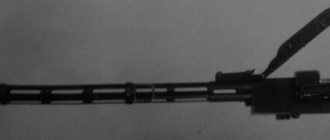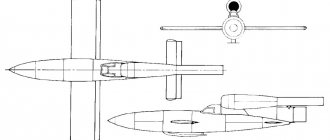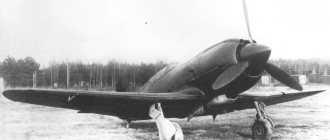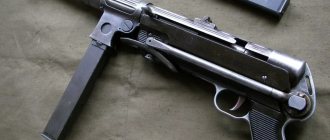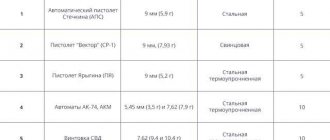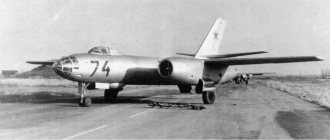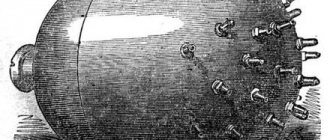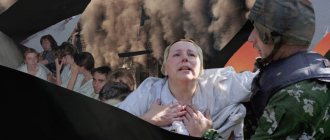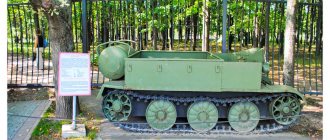| T-33 | |
| Combat weight, t | 4,5 |
| Crew, people | 2 |
| Story | |
| Number of issued, pcs. | 8 |
| Dimensions | |
| Case length, mm | 3654 |
| Case width, mm | 1948 |
| Height, mm | 1843 |
| Ground clearance, mm | 270 |
| Booking | |
| Armor type | homogeneous |
| Bottom, mm | 4 |
| Housing roof, mm | 6 |
| Gun mask, mm/deg. | 10 (machine gun shield) |
| Mobility | |
| engine's type | carburetor |
| Engine power, l. With. | 7 |
| Highway speed, km/h | 40 |
| Speed over rough terrain, km/h | 16 |
| Cruising range on the highway, km | 165 |
| Cruising range over rough terrain, km | 95 |
| Specific ground pressure, kg/cm² | 0,66 |
| Climbability, degrees. | 30° |
| Wall to be overcome, m | 0,5 |
| Ditch to be overcome, m | 1,2 |
| Fordability, m | floats |
T-33
is a light amphibious tank of the USSR, purchased in England. The first Soviet amphibious tank.
Sources
- armoretehnika.narod.ru/t33/t33.html
| Small tanks | T-33 · | |
| Escort tanks | "Renault-Russian" · "Motor ship AN" · | |
| Maneuverable tanks | T-12 · T-24 · · | |
| Breakthrough tanks | GUVP*/GUVP** · | |
| Chemical tanks | XT-26 OT-27/XT-27 MHT-1 · OT-37/HT-37 · HT-130 · HT-133 · | |
| Engineering tanks | ST-26/UST-26 · | |
| Light self-propelled guns | "Arsenalets" · T-27M · | |
| Medium and heavy self-propelled guns | 152-mm coastal self-propelled gun Tolochkova · | |
| Light armored vehicles | dietary supplement-1 · D-8/D-12 · FAI · | |
| Medium armored vehicles | BA-27 · D-9 · D-13 · | |
| Heavy armored vehicles | BA-5 BA-11 | |
| Floating armored vehicles | dietary supplement-2 · | |
| Chemical armored vehicles | D-18/37 · | |
| Self-propelled guns on a car chassis | SU-12/SU-1-12 · SU-4 · 29K · | |
| Armored personnel carriers | D-14 · | |
| Armored tractors | AT-42 · "Pioneer" · T-20 "Komsomolets" · T-26T | |
| Armored snowmobile | Grokhovsky's combat snowmobile | |
| Motorized armored carriages | D-1 · D-2 · KZ-1 ("Red Star-1") · MBV | |
| Armored railcars | D-37 · BTC · DTR · · BD-39 · BD-41 · Leningrad armored handcar | |
| Italic experimental samples and those that did not go into mass production were identified | ||
Excerpt characterizing the T-33
“Louis XVI was executed because they said that he was dishonest and a criminal (it occurred to Pierre), and they were right from their point of view, just as those who died a martyr’s death for him and ranked him among the face of the saints. Then Robespierre was executed for being a despot. Who is right, who is wrong? Nobody. But live and live: tomorrow you will die, just as I could have died an hour ago. And is it worth it to suffer when you only have one second to live compared to eternity? - But at that moment, when he considered himself reassured by this kind of reasoning, he suddenly imagined her in those moments when he most strongly showed her his insincere love, and he felt a rush of blood to his heart, and had to get up again, move, and break and tear things that come into his hands. “Why did I tell her: “Je vous aime?” he kept repeating to himself. And having repeated this question for the 10th time, Molierevo came to his mind: mais que diable allait il faire dans cette galere? [but why the hell brought him to this galley?] and he laughed at himself. At night he called the valet and told him to pack up and go to St. Petersburg. He couldn't stay under the same roof with her. He couldn't imagine how he would talk to her now. He decided that tomorrow he would leave and leave her a letter in which he would announce to her his intention to separate from her forever. In the morning, when the valet, bringing coffee, entered the office, Pierre was lying on the ottoman and sleeping with an open book in his hand. He woke up and looked around in fear for a long time, unable to understand where he was. “The Countess ordered me to ask if your Excellency is at home?” – asked the valet. But before Pierre had time to decide on the answer he would make, the countess herself, in a white satin robe, embroidered with silver, and simple hair (two huge braids en diademe [in the form of a diadem] curved twice around her lovely head) entered the room calm and majestic; only on her marble, somewhat convex forehead was a wrinkle of anger. With her all-bearing calm, she did not speak in front of the valet. She knew about the duel and came to talk about it. She waited until the valet had set out the coffee and left. Pierre looked at her timidly through his glasses, and, like a hare surrounded by dogs, his ears flattened, continues to lie in sight of his enemies, so he tried to continue reading: but he felt that it was pointless and impossible and again looked timidly at her. She did not sit down, and looked at him with a contemptuous smile, waiting for the valet to come out.
Medium tanks with a difficult childhood
The American industry started the war with the Medium Tank M2, which looked like an anachronism compared to European vehicles of the same class. The Medium Tank M3 that replaced it was also only a temporary measure. Having developed the Medium Tank M4, American designers did not rest on their laurels: already in the spring of 1942, when production of the Shermans was just beginning, they began to develop the next vehicle for the American army.
Origin of species
The concept of a new family of tanks was formed in May 1942. The base vehicle had a 76 mm cannon and was lower than the M4, which allowed designers to improve armor without exceeding its predecessor in weight. The tank also used an automatic transmission. The Armaments Committee authorized the construction of two prototypes of the vehicle, designated T20.
Soon there were several new experimental tanks. Since it was still unclear what would happen with an automatic transmission, the military decided to play it safe and build a T22 with Sherman units and a T23 with an electric transmission, which showed itself well on the Heavy Tank T1E1. Each tank had three types of weapons: the basic versions were armed with a 76-mm M1 cannon, the E1 modifications received a 75-mm cannon with an automatic loader, and the E2 received a 3-inch cannon from the M10 Wolverine tank destroyer. There was also an E3 option - these vehicles were equipped with 76 mm guns and a torsion bar suspension.
The Medium Tank T23 was superior to the M4 in armor and armament, but by 1943 the military's appetites had grown
Work on prototypes continued until early 1943, when the T23 with a 76 mm gun and electric transmission was recommended for production. It was a question of a fairly large pilot batch of 250 vehicles, but by that time the appetites of the American military had grown: the Allies became aware of the German Tigers. Even the new 76-mm gun did not take the German novelty from the distances it wanted, and the Americans did not have their own heavy tank that could fight the Tiger on equal terms.
The idea of arming the next generation tank with a 90-mm cannon with anti-aircraft ballistics arose back in October 1942, but then no one knew about the Tiger. In the spring of 1943, the developments turned out to be just in time, and by April 24, 1943, the concept of new tanks was formed. In addition to the original T23, the T25 with a 90 mm T7 gun and the T26 with the same gun and “armor equal to or superior to that of the German Mk.VI tank”
. According to preliminary calculations, a production T23 would weigh 30 tons, a T25 would weigh 33 tons, and a T26 would weigh 36 tons. From the T23 installation batch, 50 vehicles were allocated: 40 T25 and 10 T26.
90 mm anti-aircraft gun M1. American tankers wanted a gun with the same ballistics on a new generation medium tank
Plans had to be adjusted almost immediately. When the T23 grew heavier to 34 tons during development, designers began looking for a way to reduce the weight of heavier versions of the vehicle. Since the electric transmission significantly added weight to the tank, they decided to get rid of it. New versions with a torque converter installed instead of an electric transmission were called T25E1 and T26E1, both of them had a similar design. The hull was assembled from rolled armor, and only the V-shaped frontal part was cast. The thickness of the upper frontal sheets was 76 mm for the T25E1 and 102 mm for the T26E, and in both cases the sheets were installed at an angle of 46° to the vertical. The sides and rear of the T26E1 turret were 76 mm thick, and the gun mantlet was 114 mm wide across the entire front of the turret.
The improved armor came at a cost: the T26E1 still weighed an impressive 81,300 pounds (37.8 tons). To compensate, the tracks had to be widened up to 24 inches (61 cm) and the transmission ratio had to be increased so that the 500-horsepower Ford GAF engine could cope with the weight of the vehicle. The T26E1's rollers also had to be expanded.
The first damn thing is lumpy
Production of prototypes began in February 1944 and ended in May. Two of the 10 experimental T26E1s ended up at the Aberdeen Proving Ground, and one tank was sent to Fort Knox. Tests began before the end of the entire batch.
One of 10 experimental T26E1s at Aberdeen Proving Ground, 3 August 1944
The first T26E1 arrived at Aberdeen Proving Ground on 6 March 1944 and had covered 820 miles (1,320 km) by 24 March. Despite the fact that the design was based on already proven units, the T26E1 had enough problems. The bolts that connected the transmission to the engine flywheel became loose while driving. The drive wheel wore out twice as fast as on the Sherman. Testers blamed the rear-mounted transmission, which caused the track to drag a lot of abrasive particles into the wheel.
The crew's working conditions were also far from resort-like. The gunner's workplace turned out to be poorly configured; the loader had difficulty removing cartridges from the stowage - especially from those located under the fighting compartment floor. There were very few cartridges: only 42 pieces fit in the tank, while the crews demanded a minimum of 70. When firing, the fighting compartment was filled with carbon monoxide, the fan worked very weakly. The gun was nicknamed “disposable” - partly due to the fact that when fired, such a cloud of smoke rose that further shooting was not possible. Also, despite the rubber gasket, water penetrated through the turret ring.
Tank from the previous photo, rear view
By May 18, the tank had covered 1,200 miles (1,930 km). The tests revealed many additional problems. For example, due to overheating of the brakes, they had to be adjusted every 25 miles (40 km) of driving. Heavier tracks literally demolished the support rollers while driving. The second prototype, which arrived at the test site at the end of March, had by that time passed special tests of 351 miles (565 km). Tests have shown that the tank cannot cross existing pontoon bridges, except for the 25-ton one. There were problems with brake overheating.
Meanwhile, the tank at Fort Knox was being tested at the shooting range. The testers also noted that it was difficult to get cartridges, and it was impossible to adjust the fire due to dust and smoke. When fired, the turret rotated to the side by about one thousandth of a degree. The action of the torsion bar suspension was considered good.
View from above. The T26E1 turned out to be much wider than the Sherman, which led to problems
The location of the ammunition received a separate study. The testers completely removed the ammunition racks from the experimental vehicle, and the false floor of the fighting compartment was also removed. Boxes of ammunition, eight rounds each, were placed on the floor of the fighting compartment. The stacks in the boxes folded automatically when a cartridge was taken out of them. There were also 11 shells in the turret, stacked in the first stage on the wall next to the loader. Thus, 59 rounds of ammunition fit into the tank. Testers noted that another 12 rounds of ammunition could be placed on the floor of the fighting compartment if the layers of water were removed. To install the first stage, we had to sacrifice a 50-mm mortar for firing smoke bombs.
And this tank developed problems with the transmission. The torque converter failed after 184 miles (296 km) of driving and 25 hours of operation. The width of the tracks was considered insufficient. Despite the fact that the tank was already wider than all accepted dimensions, the topic of using expansion nozzles was raised. The rubber tires of the rollers also turned out to be problematic. Eight tires had to be replaced on one vehicle with an average mileage of only 8.6 miles (14 km). The suspension balancers became loose after relatively short runs. This was not a problem of excess weight: the suspension on the T25E1 failed just as quickly. Track tracks often broke.
On the left is an improved placement of ammunition in the T26E1 tank, on the right is the final version of the placement of ammunition racks on the floor of the fighting compartment. We had to abandon the wet ammunition rack, but 70 rounds of ammunition fit into the tank
During the summer and autumn of 1944, new tanks were being finalized. In addition to experiments with the units of the engine-transmission group, work was carried out on the turret and gun mount. They decided to install a muzzle brake on the 90 mm gun, but since it did not exist yet, it was necessary to change the installation so that it would be balanced both with and without a brake. For the sake of the muzzle brake, the lifting mechanism, cradle and stopper in the traveling position were strengthened. Since the British expressed interest in the new car, the aft niche was equipped to install either a British or American radio station. A first-stage stowage for 10 rounds was added to the turret, and the turret basket was removed. The layout on the floor of the fighting compartment was also different from that developed at Fort Knox. Now the cartridges were stored in two boxes of 12 each, plus 6 on the sides, where previously there were containers with water.
Solutions to problems with the gun mount and conditions for firing from a 90-mm cannon were gradually worked out, but soon problems were found with the second highlight of the tank: the armor. Firing the cast frontal part with 3-inch and 90-mm shells showed its disgusting durability and high fragility. Particularly vulnerable were the protrusions of the machine gun mount and the control compartment fan, as well as the edges of the part in the area of the chassis.
The width of the tank barely fit on a standard 25-ton pontoon bridge, and without reinforcement the bridge could not support it
The problems needed to be resolved as quickly as possible. New units should have been sent directly to the test site for testing on experimental tanks. The Armored Council conducted a panicked correspondence. By the end of the year, Chrysler expected to produce 800 of these tanks every month, but the vehicles remained so crude that it was not yet very clear which units should be put into production. As often happens, as the tank was improved, its mass gradually increased. By the end of the summer of 1944, it reached 41.7 tons, and on June 29 the vehicle was transferred to the heavy class.
At the same time, it became clear that without radical modifications the T26E1 was not combat-ready. The problem with adjusting the fire was never resolved: neither the gunner nor the commander could observe the projectile after the shot. Ventilation in the tank was still insufficient, as was the protection of various crevices from shrapnel and bullets. A successful hit from small arms could hit any crew member, as well as disrupt the operation of the gun. The new ammunition layout was approved, although it had not yet been tested by anyone. Almost all components of the machine suffered from design and manufacturing defects. The most problematic area was the chassis: out of 3,706 man-hours spent on repairing the tank, repairing the suspension and tracks took 1,112 hours, the engine - 846 hours. In total, 100 hours of tank operation required 530 hours of mechanic work.
A crane could be attached to the tower to remove the engine and transmission
The emergency situation with the T26E1 program did not at all mean that the launch into series would be cancelled. Developed in mid-1944, the requirements for vehicles that would be wanted in production in 1945 described two types of tanks: fast for developing success, and heavy for supporting infantry during a breakthrough. These requirements were directly rejected from the T25E1: although the tank had a 90 mm gun, there were no plans to cut production of the light M24 Chaffee or medium M4A3 for its sake. At the same time, there were no other contenders for the place of the heavy tank, and this role was to be filled by the modified T26E1. Such a machine received the index T26E3, but this is a topic for another story.
Electrification on a trial basis
The canceled T26 has not sunk into oblivion. The armament department authorized the construction of two experimental tanks, although on May 6 the order was cut to one. The option with electric transmission was not remade. The chassis and tracks were taken from one of the T26E1s sent to Aberdeen. The engine and transmission were identical to those used on the T23. The hull was new: the frontal armor, 102 mm thick, installed at the same angle, was now rolled. The turret was made according to the T26E1 type, but the recommended changes were introduced into the design: for example, the turret basket was removed. The tank weighed just over 43 tons.
The tank arrived at Fort Knox on October 28, 1944, and testing began on November 30. The ground pressure turned out to be acceptable - 0.84 kg per cm². The vehicle could accelerate to 28 miles (45 km) per hour, which was a decent speed for a heavy tank. The T26 overall turned out to be quite nimble. It was much easier to drive than a tank with a torque converter. On good terrain and slopes less than 11.6°, the car accelerated faster than the T26E1; on steeper slopes, the opposite situation was observed.
The Americans have been trying to equip their heavy tanks with electric transmission since the T1E1, but nothing good came of it
The tank was tested rather sluggishly. If by February 3, 1945, he covered 993 miles in 172 hours, then after that the pace of testing dropped significantly. By March 24, the tank had operated for 226 hours and traveled 1,179 miles; by May 5, 280 hours and 1,500 miles. After the victory in Europe, work on the tank practically stopped. By June 9, 1945, the tank had operated for 290 hours, covering 1,558 miles (2,500 km). By this time, it had passed 75% of the planned tests, but was idle due to a breakdown of the main generator. By July 1945, the car had worked for 302 hours, after which the engine was replaced. The tank only ran for 11 hours with the new engine before the project was cancelled. There was no point in rolling the T26 further, since neither it nor other tanks with electric transmission were going to be accepted into service. The reason was the same as for the T23: this type of transmission was considered too complex for American mechanics.
The 30-ton medium tank, invented as a replacement for the Sherman, ended up gaining more than 10 tons. Such examples occur constantly in the history of tank building. Usually, excess weight has disastrous consequences, especially the reliability of the vehicle, as was observed with the T26E1. However, the Americans did not give up. Although the Heavy Tank T26E1 was far from perfect, the general concept turned out to be correct. The construction and testing of even such samples became an important step towards the most powerful production American tank of World War II - the M26 Pershing.
Sources and literature:
- Archive Canadian Military Headquarters, London (1939–1947), RG 24 C 2
- NARA Archive
- R. P. Hunnicutt. Pershing: A History of the Medium Tank T20 Series – Echo Point Books & Media, 2015
